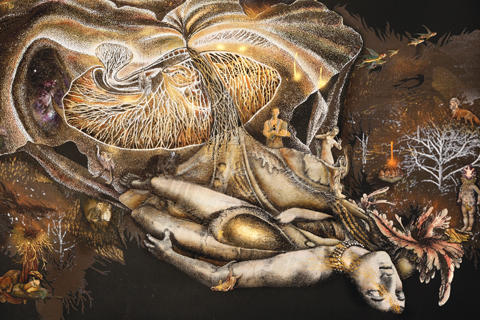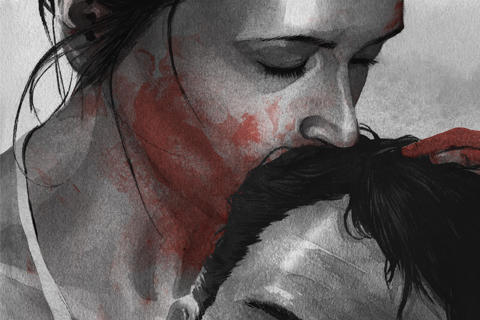Often, the most frightening thing is facing the other. In our Horror issue, this confrontation with the alien, the unknown, is presented in many forms, from the wraithlike moviegoer in Don DeLillo’s ‘The Starveling’, slinking in and out of a darkened matinee theatre, or a lovelorn tiger stalking through the suburbs in Rajesh Parameswaran’s ‘The Infamous Bengal Ming’. The stories in the issue left me wondering if the imagination is capable of conjuring absolute horror without personifying or falling prey to culturally imposed symbols.
From the Victoriana of Stoker and Poe to the pulpy aesthetics of H.R Giger and David Cronenberg we are all accustomed to the rich visual history of horror across the whole gamut of artistic expression. Giger is famed for representations of the body, peeling away the skin and recontextualising our biomechanical structure. Equally Cronenberg (a director whose work I adore) certainly in the earlier part of his career, unflinchingly set out to examine human physicality, through violence, infection and transformation; a conversation about the ever-shifting shape of the human body. Whilst these works are always compelling, challenging and inspiring, they were also beautiful. In his Philosophical Enquiry into our Ideas of the Sublime and Beautiful Edmund Burke makes a firm distinction between the sublime and the beautiful, arguing that the sublime induces a sense of being dwarfed or even horrified and beauty a sense of desire to preserve. I dreamed of an image for the cover that set out to achieve the impossible, conjoining both the beautiful and the sublime.
And so I asked the Chapman Brothers.
The Chapman Brothers’ vast body of work has long been an inspiration. Back since they created ‘Disasters of War’ I’ve been transfixed by their social and moral commentary, specifically their relentless engagement with challenging our system of context and identification over the last twenty years or so. I wanted to find out what horror can be today, in a time in which our moral boundaries shift continuously to accommodate political and economic change. With globally accessed news sites able to put you nose to nose with the scourged body of a fallen dictator, does ‘otherness’ become that more important to us?
The Chapmans’ answer to this question is beautifully succinct: an image that manages to be both everything and nothing at the same time. The delicate pencil work spawned a sprawling organic mass which is alien, yet familiar. The Horror I dreamed of: distilled.
Putting an issue of Granta Magazine together is akin to curating an exhibition space. The theme is reflected in both intricate textual detail and visually embroidered, always considering the project as a whole. The iIllustrations and imagery we create and commission to introduce the stories have a broad remit. A visual response to the piece, yet an aesthetic responsibility to the wider concept. Oat Montien’s illustration of the animal desire which permeates Rajesh Parameswaran’s Bengal Ming, somehow sits well with the altogether more hauntingly symbolic representation by Golbanou Moghaddas of Will Self’s musing on his own mortality.
The inevitable by-product of this experiment, was the overwhelming presence of the body in this issue. Or at least organic or fleshy matter of some shape or form. Physicality, distinct from mind and spirit, seems to pervade every thought about ‘otherness’. That which is familiar to us, and which we indeed are, is also the most profound, frustrating and compelling of enigmas. Fear and desire – so intrinsically linked – and witnessed through the creation, compulsion and destruction of the body. Eros and Thanatos, unable to exist one without the other.

‘Our Lady of Pain’ from ‘A Garden of Illuminating Existence’ by Kanitta Meechubot in Granta 117: Horror.
A Garden of Illuminating Existence’, Thai-born Kanitta Meechubot’s multimedia meditation on grief, illness and death leads us further to the core of nature’s perpetual duality. As in much eastern philosophy, she embraces the cyclical journey of life, love, illness and death in a beautiful, spellbinding visual poem, amidst which she muses on the effect her grandmother’s battle with womb cancer had on her grandparents’ relationship and her own understandings of grief and love. Again, beauty abounds throughout this work. Kanitta’s song is candid yet sensitive, a poetic comprehension of the incredible sophistication of the universe and where our mortality fits in to place.

Illustration by Owen Freeman for ‘The Colonel’s Son’ by Roberto Bolaño in Granta 117: Horror.
Owen Freeman also enunciates love and desire, with his own distillation of Eros and Thanatos for the late Roberto Bolaño’s ‘The Colonel’s Son’. I was introduced to Freeman’s work years ago and have been captivated ever since by the visual narrative and his cinematic depictions of human behaviour. So much so that I’ve asked him to illustrate every Bolaño story that has appeared in Granta Magazine. You could say he’s the illustrator equivalent of the legendary cinematographer Christopher Doyle. There was a natural fit between Freeman’s versatile, visceral focus on the body and Bolaño’s muscular and rather visual prose.
The Bolaño/Freeman collaboration led us to further explore the possibilities of narrating with imagery. ‘Ain’t Nothing but a Movie’ was the spawn of this happy union.
The project was pieced together by Jocabola and David Bonas in HTML5, the web language of today. The original score that strains over Freeman’s images is by Sorgerune, a long term collaborator with Jocabola. Sorgerune asked me for music references I felt appropriate for the story. It needed to be unobtrusive, yet atmospheric and unnverving. I fired some names over: Murcof, Fever Ray, Lee Hazlewood & Nancy Sinatra, How to Dress Well. I wondered where he might take it. The end result is perfectly pitched.
The allegorical nature of Bolaño’s story, which follows a ‘zombie’ B-movie as seen late at night by the narrator, led us to think about societal metaphors of infection and revolution. Which in turn made audible whispers from a voice with much to say on these matters, the late Gil Scott-Heron:
As Wall Street goes, so goes the nation. And here’s a look at the closing numbers – racism’s up, human rights are down, peace is shaky, war items are hot – the House claims all ties. Jobs are down, money is scarce – and common sense is at an all-time low with heavy trading. Movies were looking better than ever and now no one is looking because, we’re starring in a ‘B’ movie.
Visit the Roberto Bolaño-inspired HTML5 experience at Nothingbutamovie.com
Lyric excerpted from ‘B Movie’ from the album Reflections by Gil Scott Heron.







